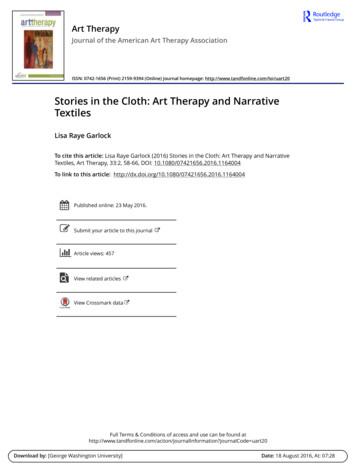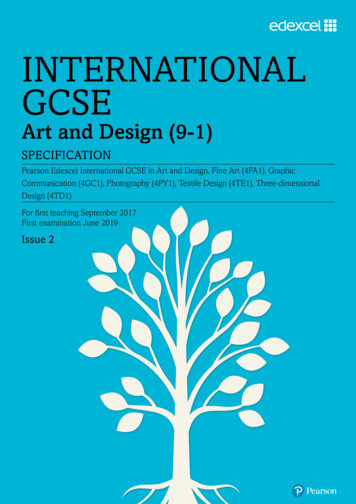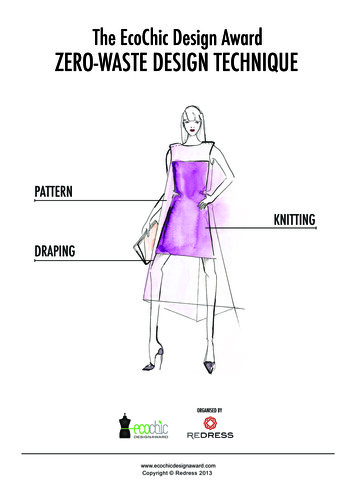
Transcription
Art TherapyJournal of the American Art Therapy AssociationISSN: 0742-1656 (Print) 2159-9394 (Online) Journal homepage: http://www.tandfonline.com/loi/uart20Stories in the Cloth: Art Therapy and NarrativeTextilesLisa Raye GarlockTo cite this article: Lisa Raye Garlock (2016) Stories in the Cloth: Art Therapy and NarrativeTextiles, Art Therapy, 33:2, 58-66, DOI: 10.1080/07421656.2016.1164004To link to this article: lished online: 23 May 2016.Submit your article to this journalArticle views: 457View related articlesView Crossmark dataFull Terms & Conditions of access and use can be found tion?journalCode uart20Download by: [George Washington University]Date: 18 August 2016, At: 07:28
Art Therapy: Journal of the American Art Therapy Association, 33(2) pp. 58–66, AATA, Inc. 2016articlesStories in the Cloth: Art Therapy and Narrative TextilesLisa Raye Garlocksponsored violence in Chile (Adams, 2014; Agosin, 1996;Moya-Raggio, 1984).The women who made the arpilleras were not just telling their stories; they were stitching their lives backtogether, supporting each other, and healing traumas in aquiet and profound way. Women have historically gatheredto sew, and in that process, alleviated personal pain by sharing their burdens and increasing their coping ability andresiliency. It can be argued that simply making an arpillera,particularly about a tragic or painful event, is by itself subversive; the maker is refusing to be silenced (Bacic, as citedin Agosin, 2014). Making a story cloth is giving voice toevents that are unspeakable, whether on a purely personallevel, or because society more broadly discourages talkingabout such things. Chansky (2010) wrote, “The needle isan appropriate material representation of women who arebalancing both their anger over oppression and pride intheir gender. The needle stabs as it creates, forcing threador yarn into the act of creation” (p. 682). The cloth canhold strong emotions, allowing anger, sorrow, joy, andother feelings to surface in imagery; the time it takes to sewa picture gives more time to process difficult or deep emotions. Sewing in community, where everyone is encouragedto tell their stories, constitutes movement toward validation, support, and connection—antidotes to the isolation,shame, and fear that many trauma survivors experience.In this article I describe narrative textiles as a mediumthat art therapists may find effective and culturally relevantwhen working with women who have experienced trauma.Starting with the introduction, I focus on the significanceof working with textiles from a cross-cultural, historical,and human rights context to a current, personal view. Ithen discuss the work of Common Threads, an integrativetraining model for therapists; describe a master’s level arttherapy course focused on sewing narrative images; andrelate how textile work helped build a sibling relationshipin my own life. Although these four aspects of textile workmay seem disparate, they are connected over time, culture,and purpose. For ages, women have used sewing and textiles for personal need and expression, and sewing in groupsnaturally strengthened their communities. This sets thebackground for me to talk about Common Threads, whichbrings sewing into contemporary trauma therapy. Showcasing student work gives concrete examples of the power ofsewing story cloths within an art therapy educational context. Relating my personal experience with textiles as aAbstractIn this article I weave together the relevance of narrativetextile work in therapeutic and human rights contexts;showcase Common Threads, an international nonprofit thatuses story cloths with survivors of gender-based violence; outlinea master’s level art therapy course in story cloths; and relatehow textiles helped build a sibling relationship. Althoughseemingly unrelated, these elements are tied together within thecontext of culture, time, and purpose, shown in the articlethrough stories and mythology, current practices, and personalexperience. Art therapists and other mental health practitionersare increasingly using sewing as a medium, particularly inplaces where it is culturally relevant, to help people tell theirstories graphically. Though art therapists may use textiles andfabric in practice, little is found in the art therapy literaturethat addresses textile work with trauma survivors. Similar totraditional art therapy groups and open studio, making storycloths in community provides connection with others and anopportunity to create, process, and cope with traumatic events.IntroductionAt first glance, the brightly colored fabric and the small,doll-like figures draw the viewer in for a closer look. Upclose, it is clear that there is a story being told that beliesthe innocent appearance. Some of the figures are dressed inuniforms, tires are ablaze, and several figures carry sticks(See Figure 1). Stitched into this arpillera, or story cloth, isa grim tale of protest and disappearances, a common andterrifying occurrence during the Chilean military dictatorship of Augusto Pinochet. No one, including the media,was permitted to talk about what was happening, but ordinary women—mothers, grandmothers, wives, and daughters—gathered to sew cloth into their own personal storiesdescribing what they and their families were experiencing.Smuggled out of the country, the cloth testimonials helpedspark the outcry for justice that eventually ended the stateLisa Raye Garlock is an Assistant Professor in the GeorgeWashington University Graduate Art Therapy Program inWashington, DC. Correspondence concerning this article may beaddressed to the author at lgarlock@gwu.eduColor versions of one or more of the figures in this article canbe found online at www.tandfonline.com/uart.58
GARLOCK59Figure 1. Anonymous (From the collection of Marilyn Anderson, used with permission)catalyst for building my sibling relationship illustrates thehealing aspects of working with textiles. Though sewing ismost often associated with women, men have also creatednarrative textiles; however, women will be the primary focusof this article. The terms story cloth, memory cloth, narrativetextile, and arpillera are used interchangeably. Permissionwas granted to use the artwork, the accompanying stories,and the personal relationship story.BackgroundFabric has been used, and continues to be used, forexpression of identity, social status, secrets, and stories.Many cultures have mastered various weaving, sewing, andfiber techniques that incorporate meaningful symbols thattell about the maker and/or wearer and their origins. Perhaps the most archetypal story is of Spider Woman.According to one Navajo source, Spider Woman createdthe entire universe through her weaving (Teller & Thompson, n.d., para. 1). Spider Woman and Spider Man alsotaught humans to weave (Leach & Fried, 1972). In Greekmythology, weaving tells a different story. Arachne, a mortal woman, challenged Athena, the goddess of wisdom anda skilled weaver, boasting that she could out-weave her.They both wove elaborate story tapestries, but whereasAthena’s depicted the stellar accomplishments of the gods,Arachne’s showed gods changing form and raping or seducing mortal women. Although Arachne’s tapestries werespectacular, her stories mocked and angered the gods, whopunished her by turning her into a spider (Bulfinch, 1979).The historical roots of textiles run deep, exist in cultureseverywhere, and continue to evolve in different ways.In the highlands of Guatemala, women from variousvillages have historically been identified by the distinctivepatterns, colors, and techniques of their handwoven clothing; each piece of cloth told symbolic stories of the weaver,her family, and the village (Anderson & Garlock, 1988).With similar meaning, but different techniques, Bedouinwomen use embroidery “as a culturally embedded speech actof female power,” and their embroidered dresses reflectsocial status and mourning, among other aspects of theirculture (Huss, as cited in Moon, 2010, p. 215). InPalestine, embroidery is used to tell stories symbolically,with the rose used as an important symbol of hope. Anexample of contemporary rose embroidery that I saw at aconference featured black bars over the center that represented political oppression in that country (F. Abdulhadi,personal communication, September 13, 2014). Althoughthis meaning may not be understood outside the culture,it’s an example of expressing worry and concern, as well assubtly commenting on the country’s state of turmoil. Theseare just a few examples of ways women express themselvesthrough textiles, and in some cases, say things visually thatcannot be said out loud.In Durban, South Africa, at the Amazwi Abasifazane(Voices of Women Museum), there is a collection of 3,000memory cloths. In 2012, the exhibit Conversations We DoNot Have was included in the annual women’s festival.According to the director of the museum and curator of theexhibit, Coral Bijoux:
60NARRATIVE TEXTILESThe memory cloths are speaking to . . . these conversationswe do not have with questions like “what are these issuesthat are highlighted and not talked about,” what are theissues that women are facing and yet are not able to speakabout. They were given a cloth, a theme—“the day I willnever forget”—and some guidelines on how they could notethis down (artistically) on the cloth. Although the womenwere not asked to remember the most painful of their stories,it is evident that the most part [sic] of their memory thatstands out involved a lot of pain and suffering. They are veryemotional, very powerful but they also speak of their victoryin surviving the traumatic experiences they might have had.(Hlatshwayo, 2012, para. 6)I viewed a selection of these memory cloths, whichwere exhibited with the story that inspired the images andphotographs of the artists at the Sew to Speak conference in2014. These memory cloths directly related to other SouthAfrican story cloths that the American Visionary ArtMuseum (AVAM) exhibited in 2012–2013. AVAM’scollection was gathered as part of the Truth and Reconciliation Commission’s attempts at justice after the overthrowof apartheid. Making these story cloths enabled the womento remember loved ones who had died and process traumain a safe way; it also connected them with others whohad likewise experienced trauma and injustice underapartheid.Quilts and blankets from around the world often tell stories and may be made from old clothing—fabric that holdsthe story and history of the wearer embedded in the weave ofthe cloth. There are stories of quilts made by slaves in whichsymbols were used to alert escaped slaves about where, when,and how to follow a path to freedom. According to Fry(1990), sewing together helped slaves find “support andcamaraderie”; the record slaves left in quilts showed “a hiddenhistory . . . of their humiliation and tragedy, the milestones oftheir times and of their own lives” (p. 83).In 2012, I saw a United Nations–sponsored exhibit ofnarrative quilts made by groups of women in marginalizedcommunities. These quilts focused on global issues of gender-based violence, women’s health, and environmentalexploitation (United Nations Population Fund, 2012).Like the Chilean arpilleras made during the Pinochetregime, the UN story cloth quilts hold the truths of themakers, and exhibiting them advocated for awareness andsolutions to their struggle. Textile story traditions are innumerable, and these traditions continue to be created bywomen and men in countries around the world. Skilled arttherapists could help deepen the expression and communication of story cloth groups by learning more about textilework in their area and then incorporating textiles into theart therapy process.Textile Work in Art TherapyKnowledge of and practice with materials is integral tobeing an art therapist. Moon (2010) discussed art media usedin art therapy from historic to current times, and noted thatthe use of traditional art materials may not be the best choicefor delivering art therapy services depending on the culture,application, and accessibility to those receiving the services.In my experience accompanying students to study abroad inIndia, traditional Western materials were not affordable orsustainable for the schools and women’s shelters there. Fabricwas readily available, and women in particular responded totextiles with excitement, knowledge, and pleasure. Thewomen were better able to express themselves artisticallyusing fabric and sewing. In their work with Bosnian Muslimrefugee women in Slovenia, Kalmanowitz and Lloyd (1999)found that embroidery was an acceptable medium whenother art materials were not. Several art therapists have usedtextiles and fiber arts in their practice and have found thatthese media can be empowering, can connect participants toprevious generations, and can promote a sense of accomplishment and ability (Moon, 2010).The act of making art, and sewing specifically, works onthe brain and body in powerful ways. Perry (2006) advocatesfor therapy for traumatized children using a neurodevelopment model, where specific actions are critical to healingtrauma. The activities must be relational, repetitive, relevant,rewarding, and rhythmic. In art therapy, many art materialsare conducive to Perry’s model. In group art therapy, some ofthe goals are communication, expression, understanding, andbuilding trust and relationships; the same is true in a storycloth group. When facilitating story cloth groups, I have seenparticipants develop trust through support, understanding,and identifying with one another. Relationships develop asstories are told, techniques and supplies are shared, andwomen work together to solve problems that may arise intheir individual art-making processes. There is repetition inthe creative process of making a story cloth, whether it’s cutting material, sewing fabric pieces, or crocheting a border.Along with repetition, sewing uses two hands simultaneously,adding an element of bilateral stimulation, used by manytherapists when working with trauma survivors. The tactilenature of sewing, touching the fabric, and tracing stitcheswith hands and fingers is similar to the process McNamee(2005) used when she had patients use dominant and nondominant hands to draw and trace over their art.These actions are also rhythmic, creating vibrations inparticipants’ bodies as they pull thread through fabric.There is a rhythm, too, in moving around for setting upand cleaning up the space, often an important ritual thatmarks the beginning and closing of art therapy groups. Inboth art therapy and story cloth groups there is also a metarhythm, an ebb and flow to the conversations that transpire;there are times of total silence as participants becomeabsorbed in their process, and then there are times whenquestions are asked, stories are told, and people interact onvarious levels. Creative acts are usually rewarding, and thesensory pleasure of touching and working with fibers andfabric can be particularly soothing and nurturing (Homer,2015). The integration of textures and colors of fabric,wool, yarn, and other materials draws on the sensory, cognitive, and emotional aspects of the maker. Relevance comesin working with materials that are developmentally andage-appropriate, and mastery of materials increases the relevance and feelings of satisfaction and accomplishment.
GARLOCKWorking with textiles can also change a person’s mood(Collier, 2011; Reynolds, 2000). Collier and von Karolyi(2014) were interested in seeing if working with textilescould be a way to alter a negative mood long-term, ratherthan just in the moment. They used the term rejuvenation,and specifically textile rejuvenation, to identify improvedmood that continued after participation in textile work(Collier & von Karolyi, 2014, p. 1). Using the PersonallyExpressive Activities Questionnaire, they found that arousaland engagement in textile activities accurately predicted textile rejuvenation, or longer term improved mood. Theirstudy may connect the varied traditions of textile work thatwomen have participated in for ages to some of the benefitsthat it has inherently served. Gantt and Tinnin (2009)developed the graphic narrative for working with traumasurvivors. Gantt’s graphic narrative is done within an intensive trauma treatment model, with support of a treatmentteam. In their process, the story is told in a series of drawings, depicting images before, during, and after the trauma.They argued that:Art therapy is effective for trauma survivors not because itbypasses defenses but because it provides a path where noneexisted previously. If peritraumatic dissociation disrupts thecoding of experience in words, memories are still laid downbut in the nonverbal part of the brain. (Gantt & Tinnin,2009, p. 151)When making a story cloth, the trauma narrativemay be expressed visually through images on fabric,which enables the pathways to open so the stories canthen be spoken. The process of sewing and working ina group allows the stories to unfold slowly, from beforethe trauma, during, and then afterward. Often the stories experienced by one individual resonate with othersin the group, reducing the feeling of being the only oneto have experienced traumatic events. Story cloth groupsfacilitated by art therapists can provide a culturally relevant form of trauma treatment for women who may nothave access to (or benefit from) traditional mental healthtreatment, particularly refugees and women in developing countries. Though sewing in community is anancient practice, art therapists as facilitators of storycloth groups can deepen the inherent healing aspects oftextile narratives and work with marginalized people todevelop confidence in telling their stories through sewing images. The next section presents an integratedmodel for training therapists in using story cloths withcontemporary trauma treatment theory and techniques.Common Threads: A Model for WorkingWith Survivors of Gender-Based ViolenceCommon Threads is an international nonprofit thatprovides a therapeutic training program for mental healthprofessionals incorporating psychoeducation, sensorimotorawareness, therapeutic art, and story cloths. As an art therapist, I consulted on therapeutic art experientials that arepart of the program, and I participate in trainings when61possible. This program targets women who have experienced gender-based violence, and it is designed to easewomen from numbing depression, anxiety, and traumarelated stress responses to a place where they can begin tofeel and function in ways that are healthy and life-affirming(R. Cohen, personal communication, September 14,2014). An option for participants in the program is to initiate an exhibit of their story cloths, which can add to thewomen’s feelings of empowerment and bring more community awareness to human rights issues.The first project of Common Threads was launched inEcuador, in the town of Lago Agrio, province of Sucumbios. Lago Agrio is an oil town, settled by men needingwork. There are an estimated 13,000 refugees living in theprovince, people who have fled the violence in Columbia(Instituto Nacional de Estadicticas y Censos, as cited inCohen, 2013, p. 4). At least 8 out of 10 women in theprovince are survivors of rape, incest, domestic violence,and/or sex trafficking (Martins, 2014). Common Threadstrained six facilitators—the director of a women’s shelterand two staff members with counseling experience, an artist, a seamstress, and an anthropologist. In an intensive2-week program, the trainees experienced the programthemselves. They learned mind/body integration exercises,incorporated culturally relevant rituals, reviewed traumatheory and psychoeducational topics, and made arpilleras.The trainees then worked with two groups of women for12 weeks, taking them through the Common Threads program (Cohen, 2013). The women continued workingtogether after completion of the program and also chose toexhibit their work, first in the capital, Quito, and then atthe United Nations in Geneva, Switzerland.Common Threads also facilitated a project in Nepal.Two of the facilitator trainees attended the Sew to Speakconference in Geneva (see below), and brought story clothsfor the exhibit. They were also working with women whohad experienced gender-based violence and were refugeesfrom Bhutan. One of the groups continued to meet,although after the April, 2015, earthquake, the focus ofwork was on dealing with the immediate needs of its aftermath (J. Shrestha, personal communication, April 30,2015).The most recent Common Threads training was inBosnia and Herzegovina, where war trauma continues toaffect survivors, individually and collectively. I was able tocofacilitate the first half of this training, along with thefounder of Common Threads and another psychologist.Fourteen women currently working in four different women’s organizations completed the first phase of the training.Most of them were already skilled in working with traumasurvivors and women dealing with domestic violence, butthe narrative textile work was new to them. Having startedtheir own story cloths, they expressed how different it madethem feel—physically and emotionally—and they wereeager to finish the training in order to start using this intervention with the women they serve. Though the trainingwas intensive, many participants said they felt energized atthe end of the day, and credited the sewing for making thedifference.
62NARRATIVE TEXTILESIn September of 2014, Common Threads organizedthe first Sew to Speak: Narrative Textiles in Human Rightsand Healing Practices conference in Geneva, Switzerland. Iwas on the organizing committee and facilitated severalworkshops. Three days were spent sharing stories, sewingtogether, and learning about some of the story cloth workthat is happening now in South Africa, Palestine, Spain,Brazil, Ireland, Canada, Kenya, Zimbabwe, England, theUnited States, Ecuador, and Nepal. This conference was afirst small step in connecting a global community of peopleusing textiles for healing and social justice.Story Cloth Class: Creating an ArtTherapy ElectiveAs a result of my involvement with Common Threads,I designed a master’s level art therapy course. It includedimportant experiential learning, cultural and social actioncomponents of art therapy, and aimed to help students integrate narrative and images at a deeper level. The curriculumincludes reading that places story cloths and arpilleras into ahistorical and cultural context, as well as articles written byart therapists who work with textiles therapeutically. Sewingis highlighted as an important medium for art therapists touse, especially when traditional Western media aren’t culturally appropriate (e.g., where art materials cannot befound, or are not sustainable or familiar). Students whotook the course found it particularly useful when they wentto India for a study abroad program. They used sewingwith the mothers of cancer patients at a hospital and at awomen’s shelter, finding that the women readily understood what to do with the materials. Rapport developedmore quickly, and the women used fabric and stories tobond with each other and cope better with the stress of theirsituations.For their assignment, students were given the option ofcreating a story cloth based on current events, a fairy tale ormyth, a personal story, or “a day I will never forget.” Thestories students depicted related to grief and loss, journeys,triumphs, life metaphors, and news events that were bothpersonal and political. Anna created the story of her friend’sfuneral (Figure 2). There were so many people there thatthe only place she could stand was midway down the centeraisle. As she sobbed, people on both sides of the aislehanded her tissues. According to Anna,At times I felt detached, like I was watching from far away.Other times I felt like I was the only person at the funeraland that the pastor was just talking to me. The momentexemplified grief. It’s having so many emotions and feelingutterly alone, despite hundreds of people sharing in yourgrief. (A. Hicken, personal communication, June 17, 2015)In Sone-seere’s story cloth, The Stage (Figure 3), sherelated her story:The inspiration for my story cloth derived from a painful andlife-changing battle I’ve traversed with a rare medical condition. In the face of pain, shame, and little answers fromFigure 2. Anna’s Arpillera: This Is a Day I’ll Never Forgetmedical teams, I rejected the notion that I was to live my lifewith this condition; so I set out on a journey to heal myself!There were times when the struggle was intense and sadnessovershadowed my thoughts, but the world, along with myobligations in life, continued. I’d often wake up in pain,force a smile on my face, and jump onto the stage of life.Often during what felt like a solo mission, I juggled the difficulties I faced and continued to dance. Ultimately, withrelentless determination and significant support, I was ableto find peace in the dance and on the stage. I began to rejoiceand could finally lift my arms in triumph, in healing, and inrebellion against shame. (S. Burrell, personal communication, August 14, 2015)Kristine’s (pseudonym) story cloth in Figure 4, TheFable of Sport, depicts Aesop’s fable of “The Boys and theFrogs.” In that fable, boys are throwing stones at frogs forentertainment. According to Kristine,The frogs cry out “Please stop! What is sport to you is deathfor us!” The fable served as a metaphor for a current, largernarrative, as well as a more personal one. The frogs’ pleainspired an image for reflection on the issues surroundingFIFA corruption and the use of brutal, often fatal slave laborto build stadiums in Qatar for the 2022 World Cup. It alsoprovided a means for reflecting on many of the vicious physical and mental training tactics employed in my long career asa highly competitive soccer player. In this way, the storycloth allowed me to work with multiple narratives as I piecedtogether a single image with fabric, needle, and thread. (K.Jones, personal communication, August 14, 2015)In Angelica’s and Sarah’s stories, they both respondedto news reports that not only sparked national outrage, butalso hit close to home and their hearts. Angelica’s storycloth, Woke From the American Dream (Figure 5), is herresponse to “watching a teenage girl be thrown to theground by an out-of-control police officer at a Texas poolparty.” In her story cloth, Angelica sees the girl as “a symbol
GARLOCKFigure 3. Sone-Seere’s Story Cloth: The StageFigure 4. Kristine’s Story Cloth: The Fable of Sport63
64NARRATIVE TEXTILESFigure 5. Angelica’s Arpillera: Woke From the American Dreamof a collective experience of what it is like to be a person ofcolor in America . . . . It is a part of a collective trauma experienced by African Americans in this country that unifiesour community.” Angelica has depicted a target in herFigure 6. Sarah’s Story Cloth: City of Flowerscloth, and states, “I am a person, deserving of respect andlove and nothing less, the color of my skin should not makeme a target.” She makes a strong visual statement, and withit the explanation that “with this story cloth, I am raisingmy hands in surrender of preconceived notions I can’t control and simultaneously in defiance of society that oppressesme.” (A. Bigsby, personal communication, August 11,2015).In Figure 6, City of Flowers, Sarah portrayed the protests in Baltimore after the death of Freddie Gray, Jr. Shechose to create her image from the viewpoint of a photographer friend, whom she represented in the top right of thecloth. According to Sarah, “There are different aspects andemotions when considering how the peaceful protests ofBaltimore were overcome by riots and how many peoplewere deeply affected.” She stated that she had “conflictingemotions varying from heartbreak to anger. This piece isnot meant to represent one side as right and another aswrong but rather how complex cultural issues are despitethe simplicity in which they can be portrayed.” (S. Mann,personal communication, August 14, 2015). Her clothraises questions about personal and collective truth and reality, and how the media can distort and sensationalizeevents. These are a few examples of how sewing images ofstories can embody deep emotions and, during the making,help the maker process the event and make sense of itwithin the context of life.
GARLOCKBuilding Relationship Through TextilesAs a fine art undergraduate student, I majored in printmaking and minored in textiles and painting. My early textile work included fiber sculptures and embroideries. As anart therapist, I expanded my use of materials to other media,and did not use textiles in my art therapy practice for anumber of years. My sister was partly responsible for bringing me back to working with textiles. She is highly analytical, works as a research manager, and we had little incommon until about 6 years ago, a year after she becamevery sick with viral meningitis. Her illness, a brain infection, affected her neurologically, and using her analyticalskills became incredibly difficult. However, though she haddone virtually no art since high school, she experienced anexplosion of creativity, which found an outlet in workingwith textiles. She has been incredibly prolific since herrecovery making quilts (particularly comfort quilts to helpothers dealing with grief and loss), facilitating workshops,and showing her work in group exhibits. Her life changedfrom spreadsheets and research models (though she stilldoes that for a living) to a life filled with textures, colors,fabric, and many talented artist friends. She expressed that“textile work is very healing on a conscious and unconscious65level for me” (B. K., personal communication, July 31,2015).We meet yearly to work on textile and fiber arts pr
art therapy process. Textile Work in Art Therapy Knowledge of and practice with materials is integral to being an art therapist. Moon (2010) discussed art media used in art therapy from historic to current times, and noted that the use of traditional art materials may not be the best choice for delivering










